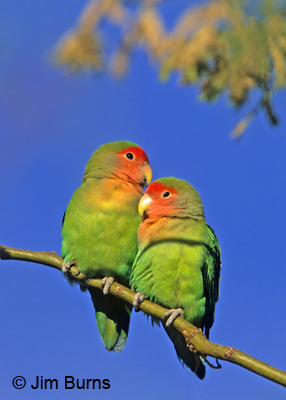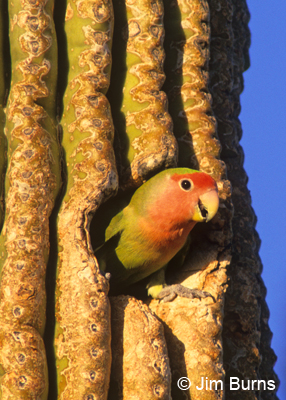October 6. 2011

You may remember these guys (the lovebirds, not Kurt and Troy) as Peach-faced Lovebirds, but the ornithological powers-that-be (again, not Kurt and Troy) have changed the name to Rosy-faced. Who knows how the minds of powers-that-be work, but at least they have retained a common name that reflects that palette of colors and the endearing lifestyle of this six inch social parrot typically seen in pairs cuddled together on a branch allopreening.
Lovebirds were first reported in Phoenix as recently at 1987, the original pairs most certainly escapees or accidental releases from exotic bird breeders. An AZFO survey conducted in February of 2010 found just under 1000 lovebirds in the Valley, and Radamaker and Corman estimate a total population of 2500(!). To say this is a self-sustaining and growing population is a wild understatement. Here are the three key factors in their growth:
Prolific breeding—as many as 3 broods/year, 4 to 5 eggs in each clutch.
Phoenix climate—warm and dry, mimicking the lovebirds native southwest Africa.
Phoenix canals—a water source (no lovebirds have been reported from natural desert areas outside the metro area).
It is interesting that Rosy-faced Lovebirds have not become established in any other U.S. city some of which, most notably Los Angeles and Miami, have large populations of multiple species of other feral parrots. It is also interesting that neither professional biologists nor hard core birders would walk across the street to observe lovebirds because they’re non-native and they’re non-countable on listers’ U.S. lists. Lovebird lovers tend to be casual birdwatchers and general outdoor enthusiasts captivated by the beauty, charisma, and accessibility of these new urban neighbors. Case in point, several years ago I made a first time visit to a medical specialist. After my exam the subject of my birding column came up, and he said, “Say, I have a birding question for you . . . .” Before he could finish I blurted out “Peach-faced Lovebird!” It was a very funny moment. He had lovebirds visiting his yard. He was not even a birder, but he was a lovebird lover. He thought I was some kind of savant.
In my book I subtitled the lovebird chapter “Beauty or Beast?” However, there has still been no evidence to date that Rosy-faced Lovebirds are negatively impacting our native fauna or flora as European Starlings and other introduced species have been proven to do. They nest primarily in untrimmed palm trees and secondarily in Saguaro cavities. We’re hoping “our” pair nest in the palm next door or the Saguaro in our front yard. We’re lovebird lovers now for sure.